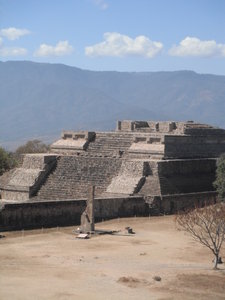Advertisement
Published: January 13th 2012

 Pyramid
Pyramid
One of the pyramids at Monte Alban. It was probably used for religious purposes. Monte Albán
This Tuesday, our class took a trip to Monte Albán, the largest archeological site in the Valley of Oaxaca. It is situated in the center of the valley, at the meeting of the three different valley arms. While its function is debated, it is possible that Monte Albán served as a central capital with political and military functions, much like modern Washington DC.
The site consists of numerous residential areas as well as large pyramids at the city center. The pyramids, typical to many in Mesoamerica, are rectangular and are orientated with the cardinal directions. The pyramids each have a large stair case, leading to one or two platforms. While many of the pyramids were roped off to tourists, we were able to climb to the top of one at the south end of the city. Unlike modern stairs, that are reasonable to climb, these stairs were almost vertical and at least a foot tall. Not the easiest hike. Despite my whining and out of breath finish, the climb was well worth it. From the top of the pyramid, you could see out onto the southern branch of the valley as well as much of the huge

 The Southern Valley
The Southern Valley
This is a view of the Southern arm of the Valley of Oaxaca from on top of the Southern most structure at Monte Alban. site.
While the pyramids were by far the most interesting and awesome structures at the site (they were all constructed without animal labor or the wheel!), we saw some other interesting features as well. The first was the Danzante wall, a wall of carved images depicting prisoners. These images depicted the prisoners dead, covered in blood with mutilated genitalia. Because they were most likely prisoners, they served as good sacrifices for the gods.
Another interesting feature was the ball court. This sunken court was the site of the ball game played at Monte Albán. While archeologists don’t know much about the game that was played here, it was most likely very similar to games played in nearby Mayan centers. While the game was a spectator sport, often the losers were then given up for sacrifice. (As you can tell, there was a lot of human sacrifice going on in Monte Albán).
After the field trip we made a quick stop to the site museum where we were able to see the actual Danzantes as well as a tomb excavated by my professor's wife. While it was a little disappointing to learn that the danzantes we saw outside

 Danzante Wall
Danzante Wall
An exact replication of the Danzante wall, now housed in the site's museum.were just plaster replicas, it was still excititing to see them in the museum.
Along this same line- One of my favorite parts about these archeological sites is the small museums attached. Rather than take these important artifacts to a centralized museum in Mexico City or the States, the artifacts stay at the site. The museums are often staffed by local residents which promotes this sense of continutity between the past and the present.
Advertisement
Tot: 0.131s; Tpl: 0.011s; cc: 11; qc: 50; dbt: 0.1028s; 1; m:domysql w:travelblog (10.17.0.13); sld: 1;
; mem: 1.1mb

 Pyramid
Pyramid
 The Southern Valley
The Southern Valley
 Danzante Wall
Danzante Wall
